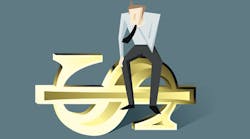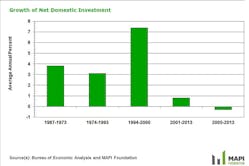What’s wrong with the U.S. economy? A number of excuses were proffered for the unexpected contraction in the first quarter of 2015 – the cold weather hampered consumer activity, the strong dollar hurt exports, the West Coast port strike created cargo backlogs, and the crash of oil prices led to layoffs. And yet this setback is hardly the exception to the rule. It’s the third quarterly contraction since the end of the Great Recession, in what has become the slowest post-recession recovery since FDR was in office.
Economic growth in this country has been stymied since the dot-com bubble burst at the turn of the century. Back in the ‘50s and ‘60s, annual GDP growth in America averaged over 4%. Even with slower growth in the ‘70s, ‘80s, and ‘90s, annual GDP growth still averaged over 3%. But in the 2000s, the average annual rate didn’t top 2%.
ITIF’s Rob Atkinson made the case for this in "Restoring America’s Lagging Investment in Capital Goods" two years ago. As he observed, high capital investment boosts economic growth because it sustains innovation, leads to substantial spillover benefits for society, and ensures a continuous refresh rate in capital goods that keeps businesses globally competitive. Hence the expansion of the ‘80s and ‘90s: business investment under Reagan averaged 2.7% growth per year and under Clinton averaged 5.2%. But the first decade of this century saw that number plummet to just 0.5% per year, and economic growth has followed suit.
In their new study, "Why Is Capital Investment Consistently Weak in the 21st Century U.S. Economy?" Norman and Duesterberg point out several key aspects that have potentially led to this moribund trend in capital investment. While some factors may already be baked into the economy, others lend themselves more readily to policy fixes. Among those that stand out:
Corporate tax policy. It’s generally recognized that tax policy is a key tool for stimulating investment; our current corporate tax code is underutilized in this area, to say the least. Two elements are at fault: First, the U.S. has the highest corporate tax rate of all our major trading partners, a distinct disadvantage considering higher tax rates raise the effective cost of capital. Second, of all the major Western countries, the U.S. is the only one that employs a worldwide tax reporting system, taxing the active foreign earnings of its corporations globally. This is a monumental disincentive to repatriating income earned overseas.
The solution: Lower effective corporate rates, allow firms to expense new business equipment, and move to a territorial reporting system.
Global trade conditions. Over the past 15 years, America has seen its global market share of exports fall from 20% to 9%. Norman and Duesterberg say this has a negative impact on domestic capital investment because it reduces the profits earned from overseas sales that go into investment. The silver lining? Over the next decade, billions of people in developing countries will enter the middle class, elevating the demand for new products and services.
The solution: Remove obstacles preventing U.S. manufacturers from supplying these potential customers’ needs. Enter into trade agreements, such as the Trans-Pacific Partnership and the Transatlantic Trade and Investment Partnership, that will reduce the overseas barriers to American products and services.
Weak business confidence. Corporate leaders are sitting on the sidelines because they’re simply unsure of the future, both economically and politically. Sputtering growth at home and slowing or even stagnant economic conditions abroad continue to make businesses cautious about where to make capital investments. Political gridlock on fundamental economic and fiscal reforms, including taxes, immigration, and entitlements, has made potential investors even more skeptical about the future.
The solution: Congress and the president should place a moratorium on the 24/7 political campaign that has consumed our federal politicians over the past decade, and show the courage and conviction to ensure a dynamic economy for future generations of Americans.




